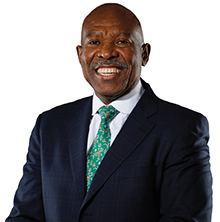“The past year was a difficult one for emerging markets in general, and South Africa was no exception,” says Lesetja Kganyago, the governor of the South African Reserve Bank (SARB), pointing to the combination of higher US dollar interest rates, prospects for a reduction in the size of advanced economy central banks’ balance sheets, rising inflation pressures, and financial crises in countries such as Turkey and Argentina. “It was therefore difficult to distinguish, when looking at movements in South African financial assets, what reflected global issues and what directly stemmed from confidence in domestic fundamentals,” he says.
South Africa’s economy entered into a technical recession in the first half of 2018, confounding expectations of a recovery amid improving domestic confidence and strong global growth, and while gross domestic product (GDP) growth rebounded to 2.2% in the third quarter of 2018, domestic growth remains sluggish against a backdrop of weak private sector fixed investment and reduced confidence.
Business confidence in South Africa has deteriorated steadily in recent quarters, says Mr Kganyago, “with a multitude of political and policy issues weighing on sentiment”. Consumer confidence has also fallen, from the highs reached in the earlier part of 2018, following the change in South Africa’s political leadership, he adds.
Resilient banks
Despite these larger economic concerns, the country’s banking sector has shown strong resilience, with total assets continuing on an upward trajectory in 2018, reaching R5500bn ($394bn) at the end of December, a growth rate of 7% year on year. “The sector’s profitability has remained resilient in the context of low economic growth, which has been largely due to cost control,” says Mr Kganyago. Meanwhile, the Tier 1 capital adequacy ratio of 13% in December 2018 was “above the regulatory requirement, indicating a high quality of capital in general”.
Even so, risks remain for the sector. “For 2019, credit risk is likely to remain a key focus area, as well as the sector’s initiatives to maintain or increase revenue without taking on any undue risk,” says Mr Kganyago. He adds that there has been an uptick in non-performing loans, particularly in the retail unsecured loans and credit cards segments.
The ratio of impaired advances has generally remained low in recent years, and while it increased in 2018, this reflected the implementation of new International Financial Reporting Standards (IFRS 9), according to Mr Kganyago. “More generally, non-bank financial institutions remain solid, including pension funds and insurance companies – even though downward pressure on household income growth in recent years has resulted in lower premium income growth for short-term insurers,” he adds.
In November, the central bank raised its benchmark interest rate for the first time in three years, by 25 basis points, over concerns about upside risks to the inflation outlook. However, since then the outlook has improved, thanks in part to a significant decline in international oil prices, continued moderation in world food prices, and a stronger and more stable domestic exchange rate, according to Mr Kganyago. “The bank now projects inflation to be much closer to the midpoint of the target in 2019 to 2021, which contributed to the decision of the Monetary Policy Committee to leave interest rates unchanged in January,” he says.
Political uncertainty remains elevated in the run-up to South Africa’s general elections in May, with many questions about the future direction of policies unanswered. “One would normally expect political noise to abate after the election. However, for uncertainty to decline in a durable fashion, the new government will have to present explicit and credible plans on how it intends to address issues such as rising public debt, the efficiency of financial health and state-owned enterprises, and the overall business regulatory environment,” says Mr Kganyago.
Global risks
Meanwhile, global risks resulting from trade tensions and other geopolitical issues, such as the risk of the UK exiting the EU without a proper transitional agreement, could negatively affect South Africa. “Because South Africa is a relatively small and open economy, its business cycle is typically sensitive to global growth and trade trends, as well as their impact on the prices of our major commodity exports,” says Mr Kganyago. “Failure by the world’s major economies to resolve the aforementioned issues would complicate South Africa’s ability to recover from a prolonged period of sub-par growth.”
Despite all this, he maintains that South Africa’s banking sector is performing well – and is a key source of stability for the economy. “The solidity of South Africa’s banking sector and its effectiveness at facilitating financial intermediation, as well as mitigating negative spillovers and disruptions, remain important reasons of optimism for South Africa’s economic outlook,” he says, adding that recent stress tests conducted by SARB suggest that banks will remain adequately capitalised, even under severe shocks.












